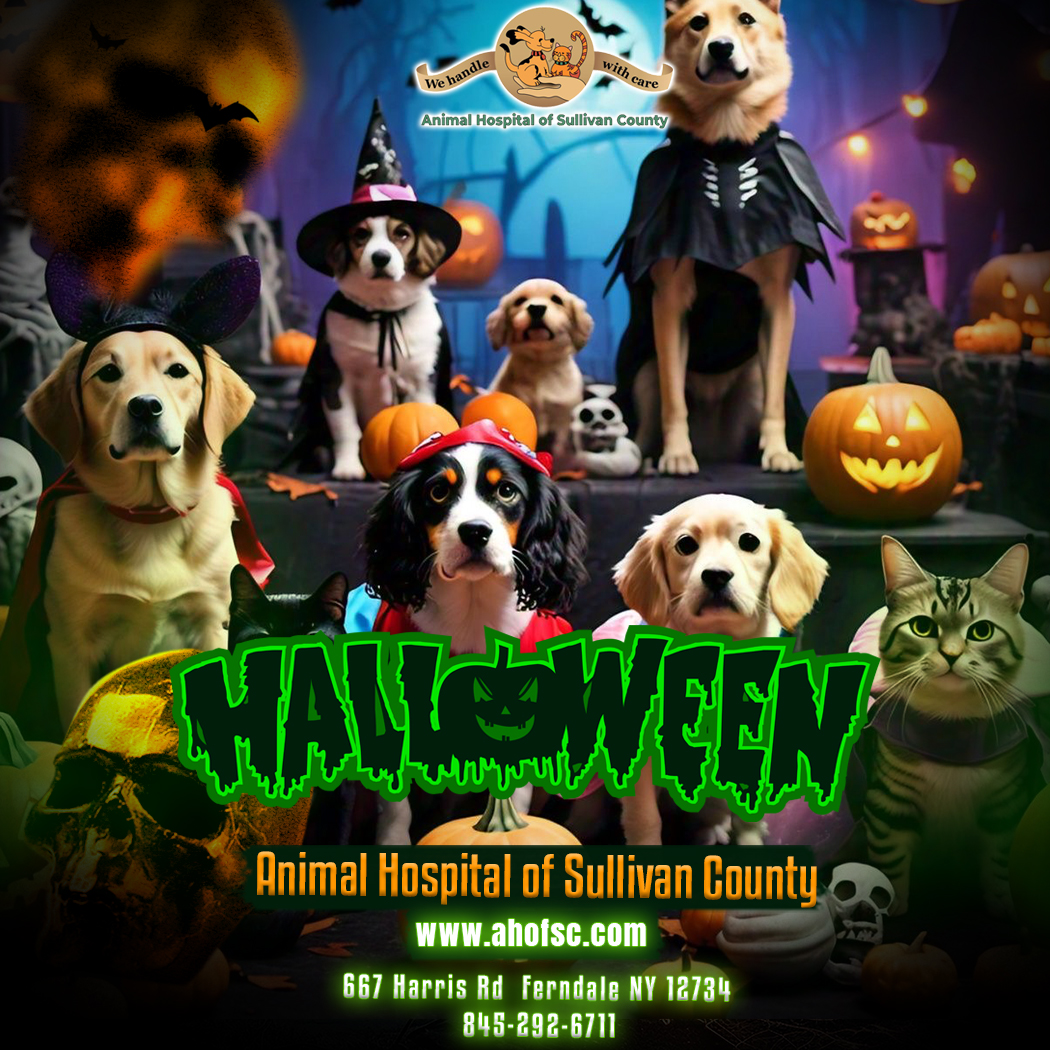
Howloween
It’s the beginning of October. You know what that means.
That’s right—Christmas decorations are being sold in practically every store.
Of course, at the end of October comes Christmas 2…or, rather, what we used to refer to as Halloween. For—as I found out for myself last year—Halloween has rapidly become the second most popular holiday in the United States.
Which means—as a veterinary professional who cares about my clients—I feel that it’s my obligation to remind everyone that dogs and chocolate just don’t go together (unless it’s a dog made out of chocolate, in which case all bets go out of the window).
Now…have you ever wondered why chocolate and doggies just don’t jibe? Well, mostly, it’s because the ingredients found in chocolate can be toxic to Tiny.
One of the prominent ingredients in chocolate is caffeine. Another is theobromine. These substances are classified as methylxanthines, which widen the bronchial airways and stimulate your pup’s nervous system. (Don’t worry; there won’t be a test later.) What you should take away from this is that these substances can speed up Tiny’s heart and increase urination. Too much of either can spell trouble. And the more Tiny has eaten, the more likely he is to have put his system in danger.
Then, we have to consider the types of chocolate. Milk chocolate, for example, isn’t really packed with methylxanthines. (This is why a medium-sized fur baby can ingest a little milk chocolate and seemingly not have a problem, leading some to believe that the “chocolate-is-bad-for-dogs thing” is just an urban myth.) Dark chocolate, on the other hand, consists of a whole lot more. And genuine cocoa powder and baker’s chocolate are the worst. They’re packed—_packed!_—with methylxanthines, and—sadly—can put down your pup pronto.
Of course, we have to take into consideration the size of your dog. One-hundred-and-twenty-pound Tiny may not have an issue ingesting a small amount of milk chocolate, but six-pound Bruiser—downing the exact same amount—might. If you’re my client, and you suspect your pooch has munched on some of the sweet stuff, follow my usual advice: call. We can evaluate the situation from there, and get you the treatment your animal companion needs.
In general, then, the rule of thumb regarding dogs and chocolate can be summarized in one word: “Don’t.” But if she does, remember that we’re right here.
That said, it might be good now to summarize some of the recommendations I made regarding pets and Halloween last year. (If you would like to read the full article, you can still find it posted on our blog page.) Let’s recap:
Remember that Halloween can be stressful for our pets. Your doggie’s natural instinct is to protect you and to alert you that a stranger is present. (Cats, meanwhile, generally prefer things to be quiet.) Trick-or-treaters unrelentingly banging on the door or pressing the doorbell can be very stressful for all of your animal friends.
My advice? Maybe put Spudley in a quiet room when the Candy Claimers come. And Bruiser might even prefer to hang in his crate.
Now, of course, there’s no doing Halloween without pumpkins, right? So, how to handle that?
In general, pumpkin can be good for dogs and cats to eat. But as the saying goes, “Everything in moderation,” because too much pumpkin can cause digestive problems. Oh, and a rotting pumpkin may have bad bacteria lurking inside, so pumpkins carved into jack o’ lanterns shouldn’t be recycled as a holiday treat for Bonkers.
And what about the costumes we might be wearing? Well, masks and costumes change how we look and smell to our fur buddies. So, even though they know us very well, they still might find the costumed version of us to be a fright…just something to keep in mind.
Some other things to keep in mind? Well…
- Don’t feed pets Halloween treats. Yes, now we all know that chocolate can be harmful—or fatal—to our pets and why. But other Halloween confections aren’t good, either. Raisins can cause kidney issues. And the American Veterinary Medical Association reports, other “candy may contain substances toxic to pets, such as chocolate or xylitol (a common sugar substitute found in sugar-free candies and gum).” My advice? Just don’t share any Halloween treats with your animal companions. And watch the kids—they might not be as vigilant as you are in keeping no-no’s away from Fido.
- Make sure your pets have identification (microchip, collar, and ID tag) that will make it easy for someone to contact you and return them home in case they escape through an open door while you’re distracted with trick-or-treaters. That’s not just good advice for Halloween; it’s best to take such precautions all year long.
- Keep lit candles, jack-o-lanterns, and other Halloween decorations out of reach of pets. Remember how excited Ozzy can get? And how running into an end table might result in a spilled drink? Well, this is kind of the same thing…but with fire. We want to avoid that.
- Keep all human costume pieces away from pets, along with glow sticks, decorations, batteries, and other holiday items. There is really no need to risk poisoning or choking your unsuspecting fur buddies in this way.
- If you plan on costuming your pet, take time before Halloween to get your pet accustomed to the costume, and never leave a costumed pet unsupervised. Sure, she might look adorable dressed as a mermaid, but keep an eye on her. You want her around for next Halloween, too.
- If Crackers is suspicious of strangers or has a tendency to bite, put him in a room away from the front door during trick-or-treating hours, or provide him with a safe hiding place. This is also good advice year-round for pets who might snap when surprised or frightened. And if you’re having a Halloween party, put a note on the door advising guests that the pets are resting in there—please do not disturb.
Hey, ever heard of the Five P’s? “Prior planning prevents poor performance”? Well, that holds true for your animal buddies and Halloween. As I noted last year, a bit of forethought goes a long way. Combined with some preparation and a little diligence, Halloween can be a fun time for everyone in the household—humans and animal friends alike!
Dr Barbara J Bodolosky DVM
Animal Hospital of Sullivan County
www.ahofsc.com
(845) 292-6711
667 Harris Rd
Ferndale NY 12734


